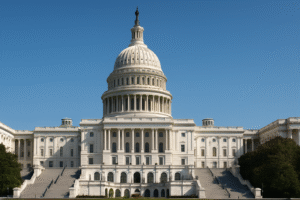Duration & Credit Pulse
Executive Summary
Bottom Line: Trade war escalation triggered the most severe fixed income volatility of 2025, with credit spreads surging to multi-month highs while Treasury yields whipsawed between 4.16% and 4.33% as flight-to-quality flows battled tariff-driven inflation fears. The S&P 500's entry into correction territory on March 13 marked a regime shift from complacency to crisis, forcing investors to confront the reality that traditional correlations have broken down in an era of weaponized trade policy and fiscal dominance.
Duration Dashboard
| Maturity | March 9, 2025 | March 16, 2025 | Weekly Δ | 5-Year Percentile |
|---|---|---|---|---|
| 2‑Year | 4.00% | 4.15% | +15 bp | 67th %ile (elevated) |
| 5‑Year | 4.09% | 4.22% | +13 bp | 74th %ile (elevated) |
| 10‑Year | 4.30% | 4.33% | +3 bp | 79th %ile (high) |
| 30‑Year | 4.60% | 4.55% | -5 bp | 78th %ile (high) |
Curve Flattens Amid Trade War Chaos
Curve Analysis: The Treasury curve exhibited dramatic flattening behavior as front-end yields surged on inflation fears while long bonds paradoxically rallied on recession concerns. The 2s30s spread compressed from 60 basis points to just 40bp—the flattest since December 2024—as markets priced in a toxic combination of near-term inflation and longer-term growth destruction. The 10-year's relatively modest 3bp increase masked extraordinary intraweek volatility, with the benchmark trading in a 17bp range between 4.16% and 4.33% as haven flows battled inflation concerns. This schizophrenic price action reflects a market struggling to price unprecedented policy uncertainty.
Treasury markets experienced their most chaotic week since the banking crisis of 2023, though end-of-week changes understated the turmoil. The 10-year yield's journey from 4.30% to an intraweek low of 4.16% on March 13—as stocks entered correction territory—before rebounding to 4.33% captured the market's inability to find equilibrium. Foreign holdings hit a record $9.05 trillion in March, providing crucial support even as domestic investors fled to cash. The curve's dramatic flattening, with 2-year yields surging 15bp while 30-years actually declined 5bp, signaled growing recession fears despite near-term inflation pressures.
Credit Pulse
| Metric | March 9, 2025 | March 16, 2025 | Weekly Δ | 5-Year Percentile |
|---|---|---|---|---|
| IG OAS | 85 bp | 92 bp | +7 bp | 28th %ile (moderate) |
| HY OAS | 300 bp | 318 bp | +18 bp | 22nd %ile (tight) |
| VIX Index | 23.37 | 26.84 | +3.47 | 85th %ile (extreme) |
Credit markets finally capitulated to reality as investment grade spreads widened 7 basis points to 92bp—still only the 28th percentile historically but the widest levels since December. High yield bore the brunt of selling pressure, surging 18bp to 318bp as the primary market effectively shut down with issuers postponing deals indefinitely. The CDX North American Investment Grade Index experienced its worst week of 2025, widening 6-7bp with March 10's 4.11bp single-day move marking the sharpest deterioration since September 2024. Dispersion exploded as transportation, retail, and commodity-sensitive names underperformed dramatically.
US Macroeconomic Assessment – Trade War Reality Shock
The week of March 10-16, 2025 will be remembered as the moment abstract trade war threats transformed into concrete economic damage, fundamentally altering the trajectory of the US economy. China's March 10 implementation of retaliatory tariffs on US agricultural exports, followed by Canada's March 13 imposition of 25% duties on $29.8 billion of American products, created immediate disruptions that reverberated through supply chains and financial markets. The psychological impact proved even more devastating than the direct economic effects, as evidenced by consumer sentiment's collapse to 57.9—the lowest reading since the depths of the 2022 inflation crisis.
Labor market shows first cracks despite headline strength: While weekly jobless claims remained contained at 220,000 versus expectations of 225,000, beneath the surface more troubling dynamics emerged. Continuing claims surged to their highest levels since 2021, suggesting those who lose jobs are finding it increasingly difficult to find new ones. Federal unemployment compensation applications spiked as Department of Government Efficiency layoffs accelerated, adding to private sector caution. The disconnect between still-low initial claims and deteriorating hiring conditions creates a particularly challenging backdrop for Fed policy, as traditional labor market signals lose their reliability.
Inflation data overshadowed by tariff reality: March 12's CPI report, showing continued moderation in underlying price pressures, should have been cause for celebration. Instead, markets largely ignored the cooler inflation print as traders recognized that backward-looking data had become irrelevant in a world of escalating trade wars. Treasury yields initially fell on the CPI release before reversing sharply as the implications of tariff pass-through became clear. Companies from Walmart to General Motors announced immediate price increases ranging from 10-25% on affected goods, rendering February's inflation data ancient history.
Consumer confidence collapse signals recession risks: The University of Michigan's preliminary consumer sentiment plunge to 57.9 from 65.0 represented one of the sharpest monthly declines on record, with the survey's chief economist noting that "tariff concerns dominated consumer psychology to an unprecedented degree." Perhaps more alarming, one-year inflation expectations surged despite the benign CPI print, suggesting consumers are already adjusting behavior in anticipation of higher prices. This toxic combination of collapsing confidence and rising inflation expectations creates the preconditions for a self-fulfilling recession as consumers retrench.
Federal Reserve Policy Outlook
The Federal Reserve finds itself trapped in an increasingly impossible position as the March 18-19 FOMC meeting approaches, with trade war escalation having fundamentally altered the policy calculus. Chair Powell's March 7 acknowledgment that "the path to sustainably returning inflation to our target has been bumpy" now seems quaint compared to the mountain range of volatility markets face. The Committee must somehow craft a message that acknowledges tariff-driven inflation risks without triggering panic about growth, all while maintaining credibility that monetary policy can address supply-side shocks it clearly cannot control.
Market pricing has shifted dramatically, with futures now showing just one rate cut priced for all of 2025, down from three cuts expected just weeks ago. More concerning, the eurodollar curve has begun pricing rate hikes for 2026, suggesting markets believe the Fed may need to combat tariff-driven inflation even at the cost of inducing recession. The updated Summary of Economic Projections on March 19 will likely show sharp upward revisions to inflation forecasts and downward revisions to growth, forcing Powell to explain how the Committee plans to navigate stagflation without the tools to address its root causes. History suggests such attempts at central bank omnipotence rarely end well.
Week Ahead: FOMC Meeting Dominates as Trade Wars Escalate
- FOMC Decision (March 18-19): The most consequential Fed meeting in years as Powell must address trade war implications. Markets expect no change to the 4.25-4.50% rate but focus on dot plot revisions and Powell's characterization of tariff impacts on the dual mandate.
- Housing Starts (March 19): February data expected to show sharp deceleration as 7%+ mortgage rates and tariff-driven material costs crush affordability. Permits will signal whether spring building season is effectively cancelled.
- Existing Home Sales (March 21): Forecast to drop to 3.9 million annual rate, potentially the lowest since 2010 as the housing market freezes. Median prices may show first year-over-year decline since 2012.
- S&P Global PMIs (March 22): March preliminary readings critical for gauging immediate tariff impact. Manufacturing expected to fall below 50 as new orders collapse; services may hold above threshold but margins tell the real story.
- Durable Goods Orders (March 25): February orders likely negative as businesses freeze capital investment amid trade uncertainty. Boeing's production issues add another layer of weakness to already-dire outlook.
US Economic Positioning and Global Context
America's self-inflicted trade war wounds are rapidly metastasizing into a global economic crisis that threatens to unravel decades of carefully constructed international cooperation. The synchronized retaliation by China and Canada this week—targeting $45 billion in US exports—represents just the opening salvo in what threatens to become a 1930s-style trade collapse. Foreign holdings of Treasuries hit $9.05 trillion even as yields proved unstable, highlighting the bizarre dynamic where global investors have no choice but to fund the very policies destroying international commerce.
Dollar dominance faces its greatest test since Bretton Woods: The week's events crystallized the inherent contradiction in Trump's economic agenda: you cannot simultaneously pursue aggressive mercantilism while maintaining reserve currency privileges. China's decision to settle more commodity trades in yuan, Europe's acceleration of digital euro development, and BRICS nations' renewed push for alternative payment systems all reflect growing determination to reduce dollar dependence. For fixed income investors, this tectonic shift implies permanently higher term premiums, reduced foreign demand for Treasuries, and volatile capital flows that amplify market stress. Credit markets' violent repricing this week may prove just a preview of the dislocations ahead as the global financial architecture fragments. The S&P 500's entry into correction territory on March 13—down 10.1% from February highs—suggests equity investors have begun to grasp what bond markets have known for weeks: the benign environment of early 2025 is definitively over, replaced by a new regime of heightened uncertainty, broken correlations, and policy-driven volatility that traditional models cannot capture.
Key Articles of the Week
-
US Credit Risk Gauge Jumps the Most in 6 Months on Growth FearsBloombergMarch 10, 2025Read Article
-
US Bonds Slip as Tariff Worries Overshadow Cooler Inflation DataBloombergMarch 12, 2025Read Article
-
Stocks sink with S&P 500 in correction, bonds in demand amid tariff angstReutersMarch 13, 2025Read Article
-
US weekly jobless claims fall amid labor market stabilityReutersMarch 13, 2025Read Article
-
Consumer sentiment plunges in early March, inflation expectations soarAxiosMarch 14, 2025Read Article
-
US consumer inflation slows in February; tariffs expected to boost pricesReutersMarch 12, 2025Read Article
-
Stock Market News for Mar 10, 2025NasdaqMarch 10, 2025Read Article






